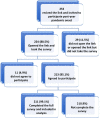Trends of Prevalence Estimates and Risk Factors of Depressive Symptoms among Healthcare Workers Over one Year of the COVID-19 Pandemic
- PMID: 37274865
- PMCID: PMC10158079
- DOI: 10.2174/17450179-v18-e2206160
Trends of Prevalence Estimates and Risk Factors of Depressive Symptoms among Healthcare Workers Over one Year of the COVID-19 Pandemic
Abstract
Background: COVID-19 pandemic has an overwhelming psychologic burden on healthcare workers (HCWs). This study aims to investigate the changes in the prevalence, estimates, severity, and risk factors of depressive symptoms among HCWs within the first year of the COVID-19 pandemic.
Methods: An observational e-survey collected data on HCWs' socio-demographic characteristics, occupational situation, and depressive symptoms as measured by Patient Health Questionnaire-9 (PHQ-9). The e-survey was distributed one month after the onset of the COVID-19 pandemic (onset group) and again after one year (one-year group).
Results: A total of 422 HCWs were included (Mean (SD) age, 35.3 (9.9) years; 71.3% males), with 211 (50%) participants in each group. In the total cohort, the mean PHQ-9 score was 8.5, and 36.7% reported clinically significant levels of depressive symptoms with a PHQ-9 score of ≥10. Compared to the onset group, the one-year group reported a higher risk of major depressive disorder (41.7% vs. 31.8%; OR 1.538; 95%CI 1.032-2.291; p=0.034), a higher mean PHQ-9 score (9.5 (6.8) vs. 7.4 (5.3), p<0.001), and more severe depressive symptoms (p<0.005). Participants who were younger, unmarried, underwent testing for COVID-19, reported lower monthly income, did not receive special COVID-19 education, or had lower satisfaction with institutional preparedness had significantly higher depression scores and symptoms in both onset and one-year groups (p<0.05 for each category). Female gender and direct contact with COVID-19 patients or samples were significant risk factors within the onset group. Occupation as a physician, history of COVID-19 testing or infection, and perception of significant changes in work schedule or intensity were significantly associated with higher depression scores and symptoms among the one-year group.
Conclusion: This study sheds light on an unspoken but significant rise in prevalence estimates and severity of depressive symptoms among HCWs over a year of the COVID-19 pandemic and shows the vulnerable subgroups for whom a psychological intervention might be warranted.
Keywords: COVID-19; Depression; Health providers; Healthcare workers; One-year; Physicians.
© 2022 Al Yassin et al.
Conflict of interest statement
The authors declare no conflict of interest, financial or otherwise.
Figures




Similar articles
-
Trends in Insomnia, Burnout, and Functional Impairment among Health Care Providers over the First Year of the COVID-19 Pandemic.Clin Pract Epidemiol Ment Health. 2022 Jul 15;18:e174501792206200. doi: 10.2174/17450179-v18-e2206200. eCollection 2022. Clin Pract Epidemiol Ment Health. 2022. PMID: 37274859 Free PMC article.
-
Prevalence Estimates and Risk Factors of Anxiety among Healthcare Workers in Jordan over One Year of the COVID-19 Pandemic: A Cross-Sectional Study.Int J Environ Res Public Health. 2022 Feb 24;19(5):2615. doi: 10.3390/ijerph19052615. Int J Environ Res Public Health. 2022. PMID: 35270333 Free PMC article.
-
Prevalence and influencing factors of depressive and anxiety symptoms among hospital-based healthcare workers during the surge period of the COVID-19 pandemic in the Chinese mainland: a multicenter cross-sectional study.QJM. 2023 Nov 24;116(11):911-922. doi: 10.1093/qjmed/hcad188. QJM. 2023. PMID: 37561096
-
Comparison of depressive symptoms among healthcare workers in high-risk versus low-risk areas during the first month of the COVID-19 pandemic in China.Front Psychiatry. 2023 Jun 13;14:1154930. doi: 10.3389/fpsyt.2023.1154930. eCollection 2023. Front Psychiatry. 2023. PMID: 37383616 Free PMC article.
-
The psychological impact, risk factors and coping strategies to COVID-19 pandemic on healthcare workers in the sub-Saharan Africa: a narrative review of existing literature.BMC Psychol. 2022 Dec 1;10(1):284. doi: 10.1186/s40359-022-00998-z. BMC Psychol. 2022. PMID: 36457038 Free PMC article. Review.
Cited by
-
Emotional distress and burnout at a fever clinic in China: Comparison between different periods of COVID-19.Front Psychiatry. 2023 Mar 13;14:1138361. doi: 10.3389/fpsyt.2023.1138361. eCollection 2023. Front Psychiatry. 2023. PMID: 36993920 Free PMC article.
-
Social support, financial status, and depression among French healthcare workers one year after the onset of the COVID-19 pandemic.BMC Public Health. 2025 Aug 16;25(1):2806. doi: 10.1186/s12889-025-24066-4. BMC Public Health. 2025. PMID: 40819033 Free PMC article.
-
Trends in Insomnia, Burnout, and Functional Impairment among Health Care Providers over the First Year of the COVID-19 Pandemic.Clin Pract Epidemiol Ment Health. 2022 Jul 15;18:e174501792206200. doi: 10.2174/17450179-v18-e2206200. eCollection 2022. Clin Pract Epidemiol Ment Health. 2022. PMID: 37274859 Free PMC article.
-
High stress related to COVID-19 among health workers in the Plateau Central healthcare region (BURKINA FASO): a cross-sectional study.Front Public Health. 2023 Jun 5;11:1162707. doi: 10.3389/fpubh.2023.1162707. eCollection 2023. Front Public Health. 2023. PMID: 37342275 Free PMC article.
-
An e-Health Psychoeducation Program for Managing the Mental Health of People with Bipolar Disorder during the COVID-19 Pandemic: A Randomized Controlled Study.J Clin Med. 2024 Jun 14;13(12):3468. doi: 10.3390/jcm13123468. J Clin Med. 2024. PMID: 38929997 Free PMC article.
References
-
- Chriscaden K. Impact of COVID-19 on people’s livelihoods, their health and our food systems. World Heal. Organ. 2020 https://www.who.int/news/item/13-10-2020-impact-of-COVID-19-on-people’s-...
-
- Allain-Dupré D., Chatry I., Kornprobst A. The territorial impact of COVID-19: Managing the crisis across levels of government. Available from: https://www.oecd.org/coronavirus/policy-responses/the-territorial-impact...
-
- Andersen A.J., Mary-Krause M., Bustamante J.J.H., Héron M., El Aarbaoui T., Melchior M. Symptoms of anxiety/depression during the COVID-19 pandemic and associated lockdown in the community: longitudinal data from the TEMPO cohort in France. BMC Psychiatry. 2021;21(1):381. doi: 10.1186/s12888-021-03383-z. - DOI - PMC - PubMed
-
- Cohut M. Global impact of the COVID-19 pandemic: 1 year on. Med. News Today. 2021 Available from: https://www.medicalnewstoday.com/articles/global-impact-of-the-COVID-19-... .
LinkOut - more resources
Full Text Sources
